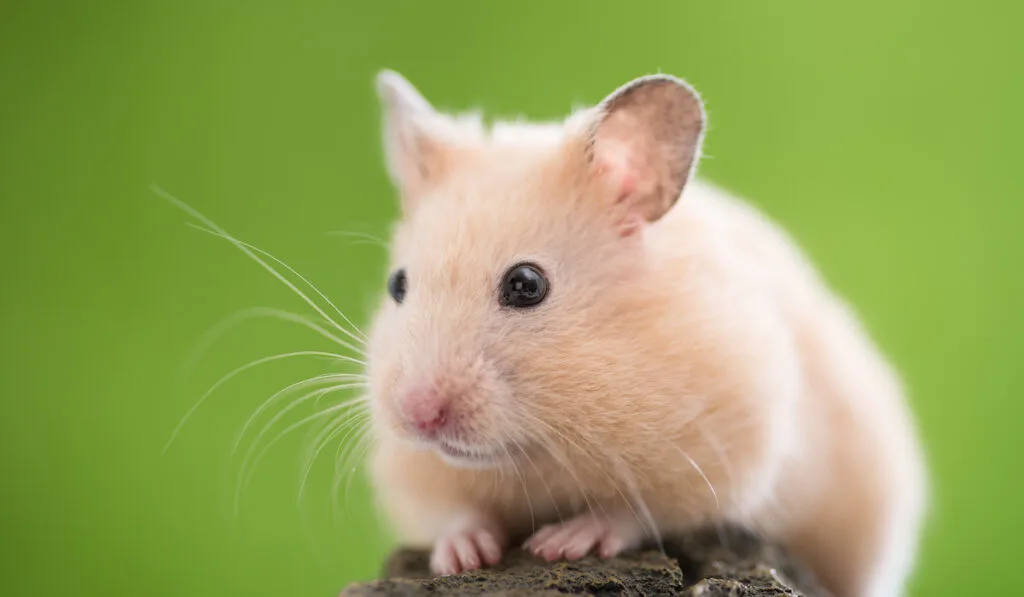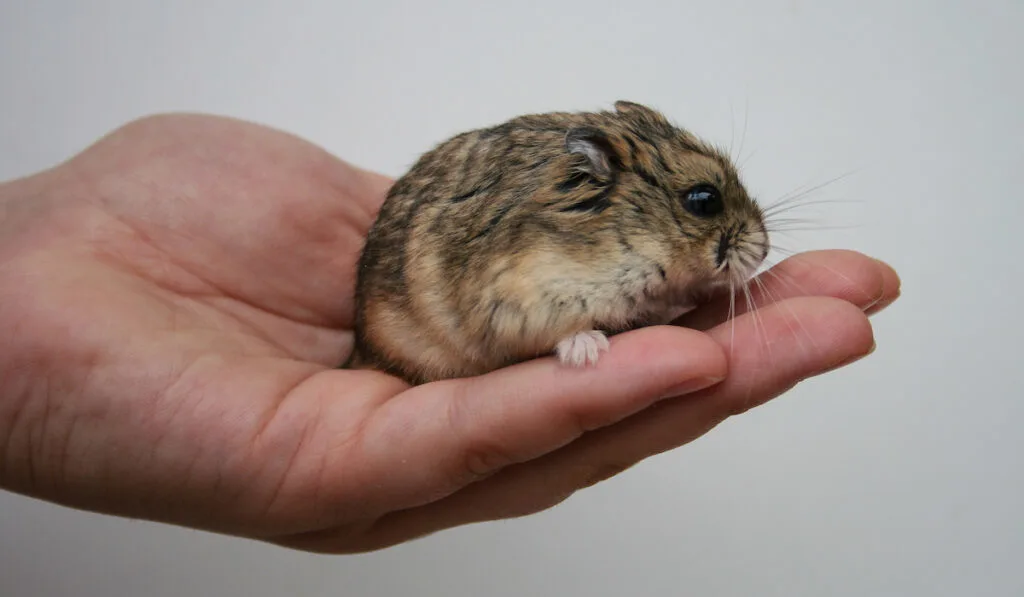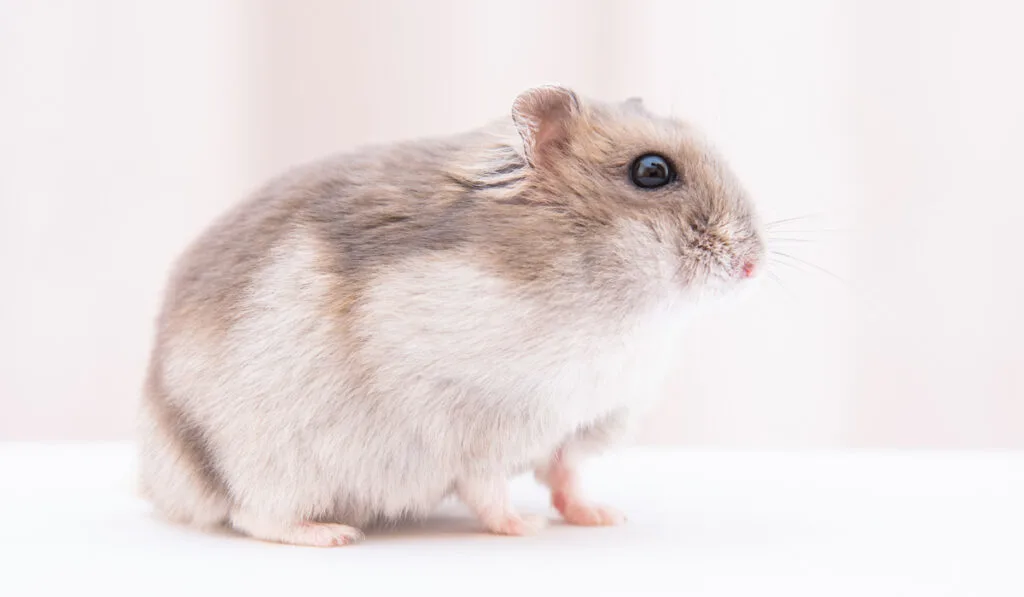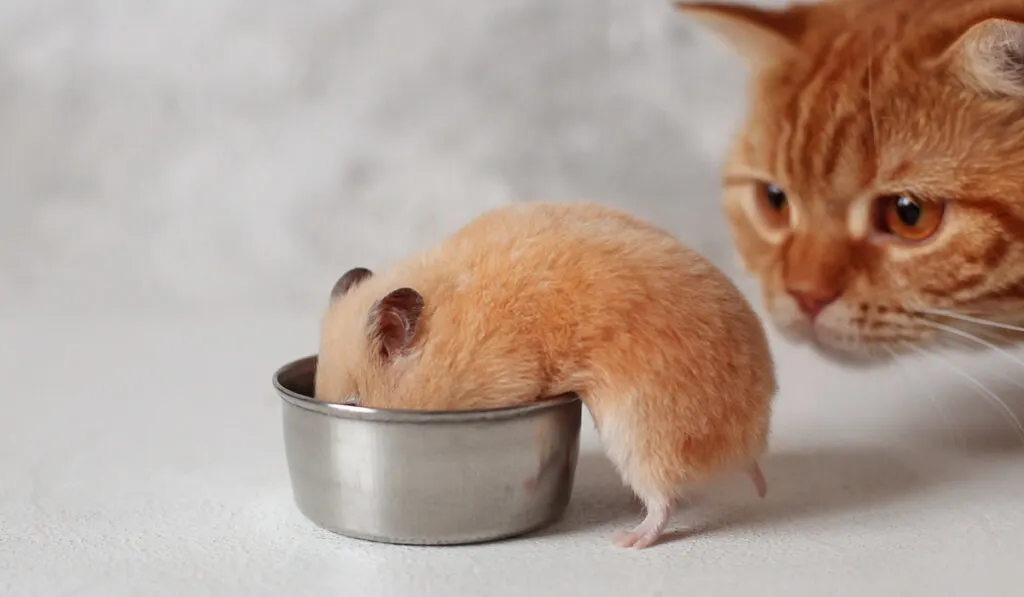Hamsters are adorable little creatures that provide love, entertainment, and a bit of mischief as a house pet. You often hear the question, “What type of dog is that?” But not as many people realize hamsters are the same as any other house pet, and they have a variety of breeds with different backgrounds and characteristics as well.
What are the different hamster breeds? There are six different types of pet hamster breeds. But there are many other species of hamsters in the wild. Their breeds signify differences in color variations, size, personality, and health traits. The six pet hamster breeds are
- Djungarian
- Syrian
- Russian Dwarf
- Siberian Dwarf (Winter White)
- Chinese
- Roborovski
Hamsters are classified in the rodent family and the subfamily Cricetinae. Learning more about the different breeds and where they come from is beneficial to anyone thinking of getting a hamster – or who is simply interested in learning more about these adorable little furballs.
Table of Contents
Hamster Breeds and Color Variations
Hamster’s furry bodies and stunningly cute large eyes make them a favorite among the rodent family. The five different breeds that are considered “pet breeds” have a wide variety of appearances and quirks.
It may seem like a less important step to research hamsters than it would a dog or a cat. With hamsters, many people pop into a pet store, find the cutest one, and cash out.
But learning more about how they adapt in certain environments and more about their characteristics when interacting with humans or other animals can be extremely beneficial to a new hamster mom or dad.
Consider all the same things you would when adopting any other type of animal.
- What are the costs associated with a hamster?
- Do you have the time for it?
- How will it play with or affect other animals in the house?
- Who will be the main caretaker?
- What types of conditions do they require?
Djungarian Hamster

I wanted to start with the Djungarian hamster to explain some questions I had about this common pet hamster breed. You see, a lot of the research I did on this breed seemed to say Djungarian’s were another name for winter white hamsters.
Likewise, I read in other places that Djungarian hamster was just another name for a Russian Dwarf Hamster. So which is it? I think I was able to find a reputable answer.
According to the book, Biomarkers in Toxicology, the Djungarian hamster is dark gray in color with a dark brown or black stripe down its back and has a belly with white fur. (source)
The Djungarian hamster also has a short tail that is typically hidden by its fur. The estimated lifespan for this type of hamster is 1 – 2 years.
In a 2002 edition of Laboratory Animal Medicine, researchers Clair Hankerson and Gerald Van Hoosier Jr. wrote an article titled, Biology and Diseases of Hamsters.
In this article, they further elaborated that most people refer to Russian Dwarf and Siberian Dwarf hamsters by the common name, Djungarian. In reality, these are believed to be two separate species of hamsters.
Still, the term Djungarian is used interchangeably for Russian Dwarf Hamsters and Siberian Dwarf Hamsters.
The Siberian dwarf hamster can molt to a pure white coat color, giving rise to it’s other popular name, the Winter White Hamster. The Russian Dwarf hamster, however, does not change color. (source)
Syrian Hamster

The Syrian Hamster, otherwise known as the Golden Hamster, is one of the most recognizable breeds. When you think of a hamster, these are typically the types you immediately picture.
They are around 5 to 7 inches long and weigh-in between 4 and 8 ounces. They got their nickname Golden Hamster due to their golden brown, cream-colored, or beige colored fur. They tend to be a blend of those golden tones plus some white on their underbellies.
They are typically the largest across all the breeds. They have a unique quality where they don’t tolerate the company of other hamsters particularly well, but they love the companionship of a human. That is why they are usually separated from their litter quickly to avoid attacks on each other.
But with humans, they love affection and playtime. They are curious as a cat and playful as a dog.
These little furballs appreciate a big cage with lots of toys and things to keep them busy. If you love the image of a hamster in a hamster ball rolling themselves around the floor of your home, you should consider this breed.
They are active at night, which may end up being a bit of trouble if you live in a small space or have their cage in your bedroom. But honestly, they’re so cute who can be mad at them anyway?
Unfortunately, the average of their short lifespan is between 2 to 3 years. This can be tough on anyone when they grow to love them. Most hamster breeds have a similar lifespan.
Additional fun facts about Syrian Hamsters:
- “Teddy bear hamsters” are Syrian hamsters with long hair.
- They make life easy on your by typically choosing one corner of the cage to relieve themselves, making clean up and odor-control more manageable.
- The Syrian Hamster is currently considered endangered in its natural habitat. Scientists estimate only 5,000 or so remain in the wild.
Russian Dwarf

The Russian Dwarf Hamster possesses some of the biggest and cutest eyes you will find on an otherwise small body. Their big eyes suck you in the second you see them.
Their small frame makes them especially cute, at only about 2-4 inches long, and they weigh only a little over an ounce. With their small size and active personalities, this can mean they are hard to hold sometimes. They love to wriggle away from you and can do so pretty easily when they are so little.
Unlike the Syrian Hamster, Russian Dwarfs are more social with their brothers and sisters than they are with humans. They still make affectionate pets but have a more prominent tendency to nip if they feel threatened.
Their small stature makes it hard for them to differentiate between a friend and a foe. Pretty much everything is bigger than them, so they feel the need to always protect themselves.
This should be a consideration if you have small children or other animals.
They may be wary around the other animals, but they do play well with fellow hamsters. If you have children, make sure to teach them that they should always approach patiently and not make sudden (scary) movements.
While they tend to be better at socializing with other hamsters, it is always best to have them socialized with each other at a young age. When a new adult hamster is introduced to another adult, the result is often tension and anxiety. So, if you plan on having multiple Russian Dwarf Hamsters, make sure to socialize them together when they are young.
Because of their small frame, they can easily escape from many wire cages. So be sure to get a wire cage that has narrow gaps between bars. Otherwise, a cage with solid sides and a ventilated roof will be a perfect option for these little guys.
They will appreciate any additional toys and tubes to run through and hide in. Hamster wheels should also be small and have bars that are close together so their little legs will not slip from the wheels.
Additional fun facts about Russian Dwarf Hamsters:
- They typically have a grayish-brown tone to their fur and white underbellies.
- Wild Russian Dwarf Hamsters will change colors in the winter to more of a white coat for protection, so they blend into the snow better.
- This breed was discovered in 1904 at the Chinese-Russian border in Mongolia
Siberian Dwarf Hamster (Winter White Hamster)

The Winter White Hamster is very similar to the Russian Dwarf. They share many of the same characteristics in their personality and appearance.
One main difference is that a Winter White tends to be less nervous than a Russian Dwarf, which means they are less likely to nip at you.
Typically very sweet and playful, their small stature still makes them a bit hard to hold onto. They are in the same size range as Russian Dwarf Hamster, but on the slightly larger end averaging more around 3-4 inches.
The colors you will find them in are Sapphire, Pearl, and a combo of the two different colors that result in beautiful color patterns.
Keep in mind that their color is often seasonal. They are typically darker in color during the summer months and molt to an ivory or white color in response to shorter days.
Additional fun facts about Winter White Hamsters:
- The Sapphire Winter Whites usually have a gray undercoat, an ivory stomach, and a gray stripe that follows their spine.
- They have the same number of chromosomes as the Russian Dwarf, which contributes to their similar sizes.
- Their bodies tend to be more rounded than any other hamster breed.
Chinese Hamster
Chinese Hamsters are also known as Striped Hamsters or Chinese Striped Hamsters. They lean more on being independent and typically do not get along well with other hamsters.
Chinese hamsters have known to become more social when they grow up around other hamsters, but they seem to be content being alone.
They will get aggressive towards other hamsters trying to show dominance, but they rarely nip or try to bite humans.
They are good-natured and typically happy animals, but they are also timid. This is why some people assume that they are not as playful as other hamsters. But many times, they just need to feel safe and this makes them seem shy.
Chinese hamsters have slender bodies and grow up to about 4 inches as adults. They are not considered a dwarf hamster but remain about the same size as some of the larger dwarf breeds. Those slightly longer and far more slender bodies are really what distinguishes them from dwarf breeds.
They also have a much longer, more easily noticed tail than other common breeds of pet hamsters.
Chinese Hamsters come in two different colors. The most common are the ones that have an agouti coat of dark brown along their back and an ivory color along their stomach. The other color is considered “dominant spot,” which consists of a white coat and spots of color.
Chinese hamsters have a slightly shorter life expectancy than many other breeds, at only about 1.5 – 2 years.
Additional fun facts about Chinese Hamsters:
- The majority of their activity comes at night, but they are known for short and active stints of playtime during the day.
- Their scientific name is Cricetulus griseus.
- They have an abnormally long tail compared to other hamsters. Between the long tail and more slender bodies, there are more reminiscent of other rodents such as small rats or mice.
Roborovski Hamster
The Roborovski Hamster is another breed that will do well with other hamsters as long as they are introduced when they are young. They are very sweet-natured around humans and rarely nip.
But their tiny stature and incredible speed make them a much easier hamster to watch and enjoy rather than to hold.
Roborovski hamsters are only about 1.5 – 2 inches long, and they love to get into the tiniest of spaces. So, if you go with a Roborovski, beware of all the smallest nooks and crannies that they may be able to sneak into if you allow them playtime outside of their cage.
Because of their small size, they are another hamster that will do better with solid sides and a ventilated roof aquarium, rather than a wire cage.
They are typically a beautiful sandy brown color with white stomachs. One of the cutest little color quirks some of them have are their small white spots they will have around their eyes and sometimes even a white face.
And while they may be the smallest of the hamster breeds, they also have the longest lifespan. Their average lifespan is 3 – 3.5 years old.
Additional fun facts about Roborovski Hamsters:
- Their scientific name is Phodopus roborovski.
- They are known for their agility as pets and in the wild, an attribute important to their survival.
- They average 2 centimeters long at birth.
Where Hamsters Originated in the Wild
When we think of hamsters, it is easy to forget they are also wild animals. They aren’t just that adorable little furry family member that runs in place on a wheel and looks adorable as they drink from a water bottle.
The first known hamsters were discovered in Syria. They were brought to the United States in 1938, according to a study done at the Louisiana Veterinary Medical Association.
Aside from their origins in Syria, according to Live Science, they are also common in the following regions:
- Romania
- Belgium
- Northern China
- Greece
Human’s first known interactions with hamsters date as far back as 1797, according to National Geographic. Physician Alexander Russell stumbled upon them out in the wild and brought light to this animal. But they wouldn’t get the name “hamster” until about 40 years later from the curator of the London Zoological Society, George Robert Waterhouse.
The earliest descriptions of the Golden Hamsters are very similar to what we see today. There have not been many changes to their coloring, size, and overall appearance over time.
Scientists are currently uncertain if they still reside in Syria, as they have always been considered rare in the wild. However, they could very well just be hiding from us.
Hamsters were brought to other countries by zoologist, Israel Aharoni. During an expedition in the 1930s, he dug 8-feet to discover a family of Golden Hamsters around the area of Aleppo, Syria.
They are now considered a vulnerable species with dwindling numbers in the wild due to loss of their natural habitat in large part due to agriculture. But we can hope that many of them are safely burrowed underground away from the destruction above them.
Can You Buy Hamsters in the US?
The quick answer to this question is yes. You can purchase hamsters in the U.S. as a pet. The better answer is to try to adopt first. There are lots of local shelters with hamsters ready for a home.
Many people jump into the purchase of a hamster before realizing certain aspects of owning them. This makes them unfortunately common in shelters when someone decides that a hamster is not the right pet for them.
Take a look around your local shelters before heading to the pet stores, and you will most likely be able to find a furry little friend waiting for you to take them home.
PETA has raised many concerns over the treatment of hamsters in pet stores, and they highly encourage everyone to adopt not shop. Smaller animals such as rodents tend to get the short end of the stick at pet stores simply because they’re small.
When you adopt from a local shelter, you are rescuing them from a near-certain death while also saying “no” to giving money to a store that creates an unhealthy environment for them.
Aside from some of the basic, broad questions we listed at the top of this article, there are other specific things to have in mind when considering adopting a hamster.

- Make sure you have a vet nearby that offers services for hamsters: Not all vets have someone that specializes in hamsters. Checking first will help make sure you are covered if anything goes wrong.
- Make sure your environment is conducive for them: Hamsters frighten easily. Some breeds more than others, but they are typically a bit on the nervous side. Make sure you have a “safe space” for them where they can feel comfortable, without fear.
- What other animals do you have? We touched on this briefly in the questions earlier, but it is worth revisiting. For example, people who own cats that pounce on every moving thing they see might see, should consider whether a hamster would feel safe in that environment.
You should consider not only the breed of the hamster but also the breed of your dog or cat. If you own a hunting breed, you will need to be extremely careful to keep them safe.
Learning About Hamster Breeds
The more you know and understand about your breed, the better living conditions you will be able to provide for it. If you have other hamsters, you’ll want to consider one of the breeds that are better suited to socialize. If you have small children, a larger breed that doesn’t tend to spook as easily may be the best option.
Once you weigh your options and think about which breed will be best for you, you should be able to find a loving hamster ready to be adopted and bring home as a new addition to your family.
